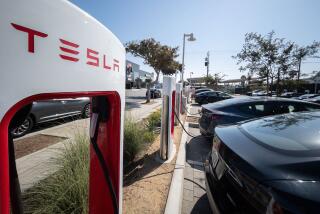Electric superbike plugs in to the future
It’s “Invasion of the Body Snatchers,” motorcycle style.
Lightning Motors’ lithium-powered superbike looks like an R1. It even handles like the Yamaha liter bike. But its innards have been wrenched and yanked out.
The entire engine is missing. So are the tailpipes, radiator, gas cap, transmission and clutch. In their place: a wall of yellow batteries, an AC regenerative motor, an electric throttle and a three-pronged plug, which pokes out from the frame and connects to a standard outlet.
Welcome to the world of electric motorcycle conversions -- a micro-phenom that’s been percolating for at least the last decade, primarily at independent motorcycle shops, like the one I visited in Oakland. Less polluting and less expensive to operate than their gas-powered brethren, electric bikes seem like a great idea. But until recently they’ve had an Achilles’ heel: the large size and low power-to-weight ratio of the lead-acid batteries propelling them.
Using lead-acid, builders have had to choose between the tortoise and the hare. Sure, they could hot-rod an electric bike to go 100 mph, but it would go only a few miles, making it useless for anything but drag racing. To get even 25 miles of life from a charge, most builders have opted for a small-displacement chassis and restricted the power output to a wimpy 50-ish mph, which is why electric bikes have a reputation for being as slow as golf carts.
Enter lithium. Specifically, lithium iron phosphate. One of several forms of lithium on the battery market, these LiFePO4, or LiFe, batteries, as they’re called, have only recently become affordable for the average Joe. They’re still four times as expensive as lead acid, but they weigh half as much, last 10 times as long and let a bike travel three times as far on a single charge.
Unlike the Tesla electric sport car, which is powered by thousands of tiny batteries, the R1 conversion uses just 28. Each of them is 90 amp-hours at 3.2 volts and 6.6 pounds. Together, they weigh less than everything that was taken off the bike to make it electric. While the majority of the batteries are concentrated in a Mondrian-esque block where the engine used to be, they’re also tucked under the seat where the exhaust was once located, to mimic the weight distribution of a stock R1.
That’s where the similarities begin to blur and separate. Turning on the bike, there’s no sound -- a potential safety issue. Riding it, the only noise I heard was the spinning of the chain and my own amazed laughter. When I rolled on the throttle, torque peaked instantly and stayed there. There was no need to shift because it’s a one-speed; there wasn’t any clutch. The digital dash included amp, volt and battery discharge information, in addition to the usual tach and speedo.
The bike’s potential horsepower is 70. Top speed: 100 mph, though I was counseled against going too fast because:
1. The bike had only recently been built and didn’t have its papers in order.
2. I was riding in a heavily policed part of Oakland.
3. The only thing stopping the batteries from sliding into the front wheel was a makeshift strap.
If only I’d visited one day later. That’s when the bike’s builders planned on installing the battery mounts. As it was, after just a few minutes of riding, I squeezed the brakes and 120 pounds of batteries bum-rushed the front fender, locking up my front end as I rolled toward a stop sign.
The Lightning Lithium is, after all, just a prototype -- an idealistic vision of what could be. Using a track-beaten 1999 Yamaha R1, the conversion cost about $15,000 total. It was the brainchild of Richard Hatfield, a motorcycle enthusiast and solar panel importer based in Burlingame, and Todd Kollin, who’s been making electric bikes out of past-their-prime gas-powered ones for the last six years at his Oakland shop, Electric Motorsport. Right now, the shop does custom conversions of aging internal-combustion bikes, with a turnaround time of about 30 days.
Within a couple years, the two hope to make a comparably priced production version of the bike using a custom chassis, as well as a smaller, less powerful $6,000 to $8,000 model.
They won’t be the first to try it. In recent years, various electric-motorcycle manufacturers have unveiled exotic and promising prototypes with faraway launch dates, but they never seem to materialize for sale. As gas prices spiral upward and lithium prices continue to fall, Hatfield and Kollin aren’t likely to be the last.
Lightning Motors’ 1999 Yamaha R1 electric conversion
Price: $15,000
Powertrain: AC regenerative motor powered by lithium iron phosphate batteries, 550-amp system, one speed
Maximum torque: 80 pound-feet
Maximum rpm: 8,000
Potential horsepower: 70
Estimated range: 80 miles at 65 mph
Dry weight: About 400 pounds
Charge time: Seven hours with on-board charger that plugs into a standard outlet






